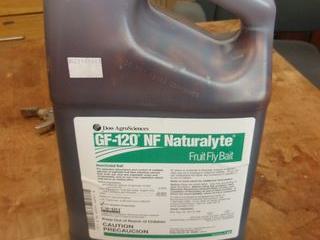
Lord of the flies?

As I posted earlier, we haven’t been able to harvest the olives from our 21 olive trees because of a serious olive fruit fly infestation. We looked into different ways to eradicate the problem without using chemicals or possibly harming our beloved bee colonies.
A few different sources recommended we use an organic insect control called spinosad, specifically GF-120, which is mixed primarily for olive fruit fly control. It’s made up of 2 components: 99.98% is a molasseslike mixture and the remaining 0.02% is the actual combo of spinosad A and D. The sweet part is used to attract the insect while the spinosad does the dirty work once they’ve eaten the goo, causing muscle contractions and paralysis. They’re dead within one to two days.
Apparently, the stuff works like a charm, but the main drawback is the price. It costs $130 dollars per gallon. Each gallon is diluted again with water into 4 sprays (that’s us measuring the proportions), or about a month’s worth.
While we were told that we only needed to spray a 2-foot square on the underside of each tree, we decided to spray a bigger area, since our trees are gargantuan compared to the typical olive tree and because we know we’ve got a major infestation.
We’re crossing our fingers that this will be miracle cure while also looking for a less expensive option. One thing we’ve already decided: we can’t possibly treat all 21 trees. We’re choosing the four that are a) shortest and easiest to treat b) most isolated from the others c) less surrounded by olive-fly-fostering shrubbery.
Sunset’s head gardener, Rick LaFrentz, spraying one of our trees.
Now we wait.



